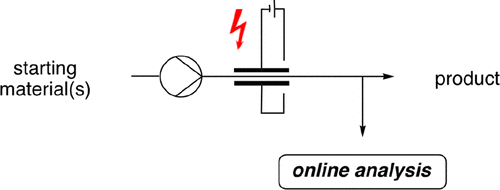当前位置:
X-MOL 学术
›
Acc. Chem. Res.
›
论文详情
Our official English website, www.x-mol.net, welcomes your
feedback! (Note: you will need to create a separate account there.)
Electroorganic Synthesis under Flow Conditions.
Accounts of Chemical Research ( IF 16.4 ) Pub Date : 2019-11-06 , DOI: 10.1021/acs.accounts.9b00497 Mohamed Elsherbini 1 , Thomas Wirth 1
Accounts of Chemical Research ( IF 16.4 ) Pub Date : 2019-11-06 , DOI: 10.1021/acs.accounts.9b00497 Mohamed Elsherbini 1 , Thomas Wirth 1
Affiliation

|
Despite the long history of electroorganic synthesis, it did not participate in the mainstream of chemical research for a long time. This is probably due to the lack of equipment and standardized protocols. However, nowadays organic electrochemistry is witnessing a renaissance, and a wide range of interesting electrochemical transformations and methodologies have been developed, not only for academic purposes but also for large scale industrial production. Depending on the source of electricity, electrochemical methods can be inherently green and environmentally benign and can be easily controlled to achieve high levels of selectivity. In addition, the generation and consumption of reactive or unstable intermediates and hazardous reagents can be achieved in a safe way. Limitations of traditional batch-type electrochemical methods such as the restricted electrode surface, the necessity of supporting electrolytes, and the difficulties in scaling up can be alleviated using electrochemical flow cells. Microreactors offer high surface-to-volume ratios and enable precise control over temperature, residence time, flow rate, and pressure. In addition, efficient mixing, enhanced mass and heat transfer, and handling of small volumes lead to simpler scaling-up protocols and minimize safety concerns. Electrolysis under flow conditions reduces the possibility of overoxidation as the reaction mixture is flown continuously out of the reactor in contrast to traditional batch-type electrolysis cells. In this Account, we highlight our contributions in the area of electroorganic synthesis under flow conditions over the past decade. We have designed and manufactured different generations of electrochemical flow cells. The first-generation reactor was effectively used in developing a simple one-step synthesis of diaryliodonium salts and used in proof-of-concept reactions such as the trifluoromethylation of electron-deficient alkenes via Kolbe electrolysis of trifluoroacetic acid in addition to the selective deprotection of the isonicotinyloxycarbonyl (iNoc) group from carbonates and thiocarbonates. The improved second-generation flow cell enabled the development of efficient synthesis of isoindolinones, benzothiazoles, and thiazolopyridines, achieving gram-scale for some of the products easily without changing the reactor design or reoptimizing the reaction parameters. In addition, the same reactor was used in the development of an efficient continuous flow electrochemical synthesis of hypervalent iodine reagents. The generated unstable hypervalent iodine reagents were easily used without isolation in various oxidative transformations in a coupled flow/flow manner and could be easily transformed into bench-stable reagents via quantitative ligand exchange with the appropriate acids. Our second-generation reactor was further improved and commercialized by Vapourtec Ltd. We have demonstrated the power of online analysis in accelerating optimizations and methodology development. Online mass spectrometry enabled fast screening of the charge needed for the cyclization of amides to isoindolinones. The power of online 2D-HPLC combined with a Design of Experiments approach empowered the rapid optimization of stereoselective electrochemical alkoxylations of amino acid derivatives.
中文翻译:

流动条件下的有机合成。
尽管有机电合成的历史悠久,但很长一段时间以来它一直没有参与化学研究的主流。这可能是由于缺少设备和标准化协议所致。然而,如今有机电化学正在复兴,并且已经开发了许多有趣的电化学转化和方法,不仅用于学术目的,而且还用于大规模工业生产。取决于电力来源,电化学方法本来可以是绿色的且对环境无害,并且可以容易地控制以实现高水平的选择性。另外,可以安全地实现反应性或不稳定的中间体和危险试剂的产生和消耗。使用电化学流通池可以减轻传统分批式电化学方法的局限性,例如受限制的电极表面,支撑电解质的必要性以及扩大规模的困难。微型反应器具有高的表面体积比,可以精确控制温度,停留时间,流速和压力。另外,有效的混合,增强的质量和热传递以及小体积的处理导致更简单的按比例放大方案,并最大程度地减少了安全隐患。与传统的间歇式电解槽相比,在流动条件下进行的电解减少了过氧化的可能性,因为反应混合物连续地从反应器中流出。在这个帐户中,在过去的十年中,我们重点介绍了我们在流动条件下的有机合成领域中的贡献。我们设计和制造了不同代的电化学流通池。第一代反应器有效地用于开发二芳基碘鎓盐的简单一步合成,并用于概念验证反应,例如除三氟乙酸的选择性脱保护外,还通过三氟乙酸的Kolbe电解法对缺电子烯烃进行三氟甲基化。碳酸盐和硫代碳酸盐中的异烟酰氧羰基(iNoc)基团。经过改进的第二代流通池可以开发出高效合成异吲哚啉酮,苯并噻唑和噻唑并吡啶的方法,无需更改反应器设计或重新优化反应参数,即可轻松实现某些产品的克级。另外,同一反应器用于开发高价碘试剂的有效连续流电化学合成。生成的不稳定的高价碘试剂易于使用,无需以流/流耦合方式在各种氧化转化中进行分离,并且可以通过与适当的酸进行定量配体交换而容易地转化为稳定的试剂。我们的第二代反应堆由Vapourtec Ltd进一步改进和商业化。我们已经展示了在线分析在加速优化和方法开发方面的强大功能。在线质谱分析能够快速筛选酰胺环化为异吲哚啉酮所需的电荷。在线2D-HPLC的功能与“实验设计”方法相结合,可以快速优化氨基酸衍生物的立体选择性电化学烷氧基化反应。
更新日期:2019-11-07
中文翻译:

流动条件下的有机合成。
尽管有机电合成的历史悠久,但很长一段时间以来它一直没有参与化学研究的主流。这可能是由于缺少设备和标准化协议所致。然而,如今有机电化学正在复兴,并且已经开发了许多有趣的电化学转化和方法,不仅用于学术目的,而且还用于大规模工业生产。取决于电力来源,电化学方法本来可以是绿色的且对环境无害,并且可以容易地控制以实现高水平的选择性。另外,可以安全地实现反应性或不稳定的中间体和危险试剂的产生和消耗。使用电化学流通池可以减轻传统分批式电化学方法的局限性,例如受限制的电极表面,支撑电解质的必要性以及扩大规模的困难。微型反应器具有高的表面体积比,可以精确控制温度,停留时间,流速和压力。另外,有效的混合,增强的质量和热传递以及小体积的处理导致更简单的按比例放大方案,并最大程度地减少了安全隐患。与传统的间歇式电解槽相比,在流动条件下进行的电解减少了过氧化的可能性,因为反应混合物连续地从反应器中流出。在这个帐户中,在过去的十年中,我们重点介绍了我们在流动条件下的有机合成领域中的贡献。我们设计和制造了不同代的电化学流通池。第一代反应器有效地用于开发二芳基碘鎓盐的简单一步合成,并用于概念验证反应,例如除三氟乙酸的选择性脱保护外,还通过三氟乙酸的Kolbe电解法对缺电子烯烃进行三氟甲基化。碳酸盐和硫代碳酸盐中的异烟酰氧羰基(iNoc)基团。经过改进的第二代流通池可以开发出高效合成异吲哚啉酮,苯并噻唑和噻唑并吡啶的方法,无需更改反应器设计或重新优化反应参数,即可轻松实现某些产品的克级。另外,同一反应器用于开发高价碘试剂的有效连续流电化学合成。生成的不稳定的高价碘试剂易于使用,无需以流/流耦合方式在各种氧化转化中进行分离,并且可以通过与适当的酸进行定量配体交换而容易地转化为稳定的试剂。我们的第二代反应堆由Vapourtec Ltd进一步改进和商业化。我们已经展示了在线分析在加速优化和方法开发方面的强大功能。在线质谱分析能够快速筛选酰胺环化为异吲哚啉酮所需的电荷。在线2D-HPLC的功能与“实验设计”方法相结合,可以快速优化氨基酸衍生物的立体选择性电化学烷氧基化反应。











































 京公网安备 11010802027423号
京公网安备 11010802027423号